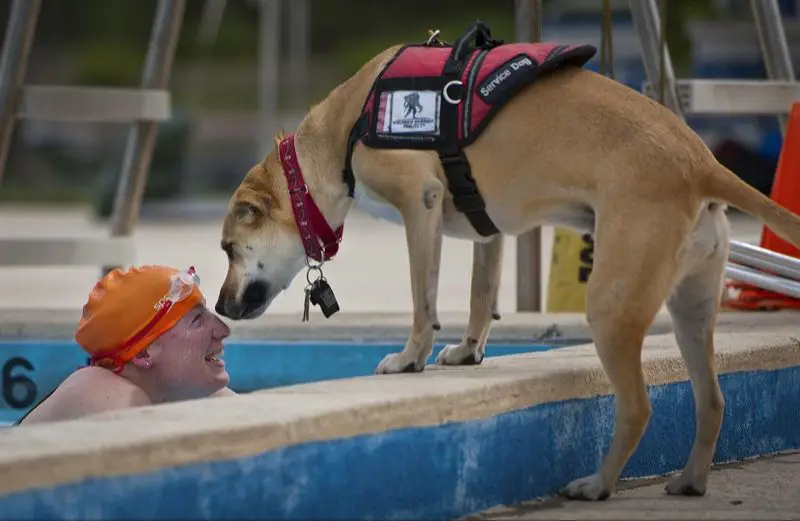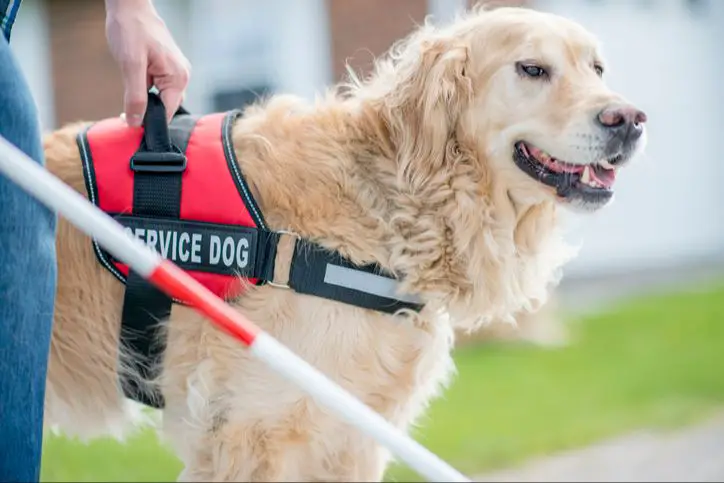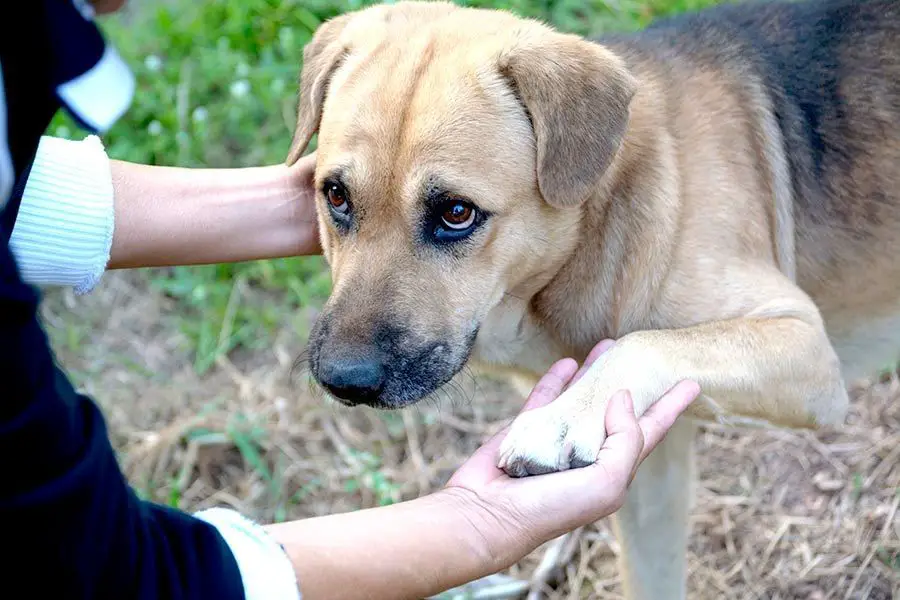What are service dogs and what do they do?
Service dogs are trained to perform tasks that assist people with disabilities. According to the Americans with Disabilities Act (ADA), a service dog is defined as a dog that is individually trained to do work or perform tasks for a person with a disability (https://www.ada.gov/service_animals_2010.htm).
There are many different types of service dogs that are trained to help people with various disabilities. Some examples include:
- Guide dogs for the blind or visually impaired
- Hearing dogs for the deaf or hard of hearing
- Mobility assistance dogs for those with mobility impairments
- Seizure alert/response dogs for those with epilepsy
- Diabetic alert dogs to detect blood sugar changes
- Psychiatric service dogs for those with mental health conditions like PTSD, depression, anxiety, etc.
Service dogs can perform a wide variety of tasks to help mitigate their handler’s disability such as guiding them, retrieving items, opening/closing doors, turning lights on/off, providing stability and balance support, alerting to medical emergencies like seizures or low blood sugar, calming anxiety, and more (https://anythingpawsable.com/100-examples-service-dog-tasks/).
Under the ADA, service dogs are permitted access to accompany their handlers in public places like restaurants, shops, schools, and on transportation. Business owners and staff may only ask if the dog is a service animal required for a disability and what tasks the dog has been trained to perform.
Temperament traits important for service dogs

Service dogs need to have the right temperament and personality traits to succeed in their important jobs supporting people with disabilities. Some of the most important temperament traits for service dogs include:
Calm, focused – Service dogs need to be able to focus on their handler and work calmly without being distracted in public settings. A service dog that is overly excitable or reactive would not be suitable.
Non-aggressive – Service dogs should never show any aggression towards people or other animals. They need to have a friendly, tolerant temperament.
Social, people-friendly – Service dogs will encounter many new people every day, so it’s crucial that they feel comfortable being petted, handled and approached by strangers. Dogs that are shy, aloof or wary of strangers would not make ideal service dogs.
Confident – Service dogs need to be confident in new environments and situations. They should not be overly timid, nervous or anxious when facing new challenges in their training and working roles. Confidence helps service dogs handle unfamiliar settings and stimuli.
(Source: https://pawsandclawsvet.com/becoming-a-service-dog-training-and-temperament-are-key-factors/)
Common service dog breeds
Certain dog breeds are well-suited for service work due to their temperament, intelligence, trainability, and physical build. According to the AKC, some of the most popular service dog breeds include:

- Labrador Retrievers – Labs are one of the most popular breeds for service dogs. They have a friendly, eager-to-please temperament and are highly trainable. Their moderate size provides mobility assistance while not being too large. Labs make excellent guide dogs, hearing dogs, seizure response dogs, and more. They are energetic working dogs that thrive when given a job to do.
- Golden Retrievers – Like Labs, Goldens have an ideal combination of trainability, intelligence, gentleness and affordability that makes them well-suited for service work. Their loving personalities provide emotional support. Their physical strength allows them to aid with mobility and balance. Goldens commonly work as guide dogs, hearing dogs, medical alert dogs, and psychiatric service dogs.
- German Shepherds – Known for their confidence, courage and trainability, German Shepherds excel as service dogs. Their protective nature and loyalty inspires public trust. They are prized as guide dogs and are often chosen for search and rescue work, police work, and scent detection. Their large size provides substantial mobility assistance.
- Poodles – Poodles are eager to please, highly intelligent, and hypoallergenic. They adapt well to new situations and are less distractable than some hunting breeds. Standard poodles are large enough to aid with mobility tasks. Miniature poodles make ideal hearing dogs. All sizes work well for diabetic alert, psychiatric service, and seizure alert work.
When researching service dog breeds, focus on temperament and trainability over specific breed characteristics. Many dogs have the potential to work in service roles with proper training and socialization (source).
Training required for service dogs
Training a service dog requires dedication and hard work over an extended period. While service dogs are not required to be professionally trained per the Americans with Disabilities Act (ADA), they do need substantial training to perform their duties properly. Some key aspects of service dog training include:

Socialization as a puppy – Early socialization helps set the foundation for a successful service dog. Puppies should be exposed to a wide variety of sounds, people, animals, and environments during the critical developmental stage from 3 weeks to 16 weeks old. This helps build confidence and ensures they can remain focused later during public access training.
Basic obedience – All service dogs need to master basic obedience commands like sit, stay, come, down, heel, and leave it. Obedience provides control and allows the dog to focus on its handler. While the ADA does not specify training standards, organizations suggest at least 120 hours of training over 6 months for basic obedience.
Public access skills – For access rights, service dogs must be trained to behave appropriately in public settings. This includes manners and ignoring distractions in restaurants, stores, crowded areas, public transportation, etc. Public access skills are an essential part of service dog training.
Task-specific training – Depending on the disabilities a service dog will assist with, specialized training is required for particular tasks. This may include guiding for visually impaired handlers, seizure alerts/response, mobility assistance, psychiatric assistance tasks, and more tailored to the individual’s needs.
Adequate training and proof of control are required for legal public access with a service dog. While individuals can self-train their service dogs, professional programs may be the best option for handlers without dog training experience.
Is my dog a good candidate? Temperament considerations
One of the most important factors when considering a prospective service dog is having the right temperament. According to Becoming a Service Dog: Training and Temperament Are Key Factors, key temperament traits for service dogs include being calm, patient, confident, gentle and focused. The dog should not be easily distracted or reactive and should be comfortable in a variety of environments.

Signs that a dog may not be suited for service work include severe separation anxiety, fearfulness or nervousness, and reactivity towards people, animals or noises. Even mild reactivity could be problematic, as service dogs need to maintain composure in public settings. According to Evaluating Service Dog Candidates At the Shelter: 5 Traits to Look For, the ideal temperament is someone quiet, relaxed, gentle, social, responsive and balanced.
Observing the dog at home and in public can help determine if it has the proper temperament. A dog that is constantly on high alert, pace or startles easily may struggle with service work. The dog should show confidence, self-control and a willingness to listen to commands and direction.
Is my dog a good candidate? Health considerations
When evaluating whether your dog is physically suited to service work, it’s important to consider their overall health and physical soundness. Service dogs need to be able to handle the rigors of public access and working constantly at their handler’s side, so any significant health issues may disqualify them.
Some key health factors to consider include:
- Physical soundness – Service dogs should not have any disabilities or mobility issues that would interfere with their work. They need to be able to walk steadily for long periods and perform tasks like retrieving items.
- Energy levels – Service dogs need moderate to high energy levels to handle being on duty. A dog that tires easily may not be able to work a full day consistently.
- Common disqualifying conditions – Dogs with chronic illnesses or progressive diseases like hip dysplasia are generally not recommended. Epilepsy, significant allergies, or digestive issues may also interfere with service work. Any condition that causes chronic pain or unpredictable flare-ups is typically disqualifying.
A full medical exam by your veterinarian can help identify any health issues to consider. Ongoing veterinary care and maintenance like vaccinations, parasite prevention, and dental cleanings are also crucial to keep a service dog physically ready for work. With a clean bill of health and appropriate energy levels, your dog has a good foundation physically to train as a service dog.
Is my dog a good candidate? Age considerations
The ideal age to begin training a dog to become a service dog is around 6 months to a year old. This is when puppies have finished with the critical socialization period but are still young enough to be very trainable. According to the Servicedogtrainingschool.org, “The optimal age for a dog to become a service dog is considered the age of 2. This is the “adolescence” age stage and it matches the age of a 12-13 year old child going through puberty.”
While starting training in puppyhood sets a service dog up for success, it is also possible to train older dogs. An older dog that is well-socialized and demonstrates the right temperament can make a great service dog with the proper training. The key is finding an older dog that is focused, attentive, and eager to work. With consistency and positive reinforcement, they can pick up on the complex skills required. However, it typically takes more time and effort compared to training a younger puppy without ingrained habits.
Sources:
https://www.servicedogtrainingschool.org/blog/service-dogs-age-requirements
https://www.k-9culture.com/post/how-long-does-it-take-to-train-a-service-dog
Other considerations for prospective service dogs
There are a few other important factors to consider when determining if your dog would make a good service dog candidate:
Size and breed restrictions
While most breeds can make good service dogs, some size/breed restrictions may apply depending on your needs. For example, small dogs or short-nosed breeds may not be suitable for mobility work. Certain public spaces or housing may have breed restrictions against perceived “aggressive” breeds like pit bulls or rottweilers. Consider these restrictions when selecting your candidate.
Sources:
https://www.akc.org/expert-advice/training/service-dog-training-101/
Time commitment
Proper service dog training takes significant time and dedication. Expect to commit at least 120 hours over 6 months of consistent, positive reinforcement training to teach your dog the skills needed. Daily practice of obedience and commands is a must. If you cannot dedicate this time, a service dog may not be right for you.
Sources:
https://www.servicedogcertifications.org/service-dog-requirements/
Cost of training
While you can choose to self-train your service dog, professional training programs can cost $10,000-$30,000+. Consider the costs of training equipment, veterinary care, food, grooming, etc. Proper training is an investment. If you cannot afford these costs, exploring other service dog options may be prudent.
Sources:
https://www.ada.gov/resources/service-animals-faqs/
What if my dog isn’t suited to service work?
Just because your dog may not be an ideal candidate for service dog work does not mean they cannot still have an active, fulfilling role. Here are some alternative jobs and activities for dogs not suited for service work:
Therapy dog work. While therapy dogs do not need to perform physical tasks for their handlers, they still need a friendly, calm temperament to visit hospitals, schools, nursing homes, and other facilities. Therapy dog certification has less stringent requirements than service dogs, so this can be a good option for well-behaved dogs. Learn more about therapy dog requirements.
Enjoy life as an active pet. If your dog is healthy and stable but easily distracted, they can still make a wonderful pet! Focus on providing them with exercise, mental stimulation, and lots of quality time with you. Take them hiking, get interactive puzzle toys, practice obedience skills, take training classes together – a “job” for them can simply be staying active and spending time with you.
Try dog sports. If your dog is energetic, intelligent but needs more direction, look into dog sports like agility, flyball, dock diving, or nosework competitions. These are fun, bonded activities providing an outlet for their working drive.
In the end, any happy, healthy dog can have an fulfilling life and bond with you. Service work is just one path – make the most of your unique dog’s personality and energy!
Next steps if my dog seems like a good candidate
If after reviewing your dog’s temperament, health, and age suitability it seems like they may be a good fit for service dog work, here are some next steps to take:
Consult a professional service dog trainer. Get an evaluation of your dog’s abilities and aptitude. A trainer can assess if your dog has the right temperament and skills for the rigorous training required. Working with an experienced trainer from the start can set you and your dog up for success. See this source for guidance on finding a qualified trainer.
Have your vet thoroughly evaluate your dog’s health. Service dogs need to be in excellent physical condition to handle the demands of their job. Your vet can check for any health issues that may interfere with service work.
Arrange formal temperament testing. Organizations like the AKC’s Canine Good Citizen program offer testing to evaluate temperament. This provides objective feedback on how suitable your dog’s temperament is for ongoing service dog training.
Mentally prepare for the intensive training ahead. Service dog training takes significant commitment, time and hard work from both dog and human. Make sure you’re ready to fully dedicate yourself before embarking on this journey with your dog. The reward of a life of service together makes the effort worthwhile.
